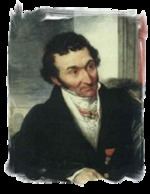Name Chrystian Aigner | Role Architect | |
 | ||
Chrystian piotr aigner
Chrystian Piotr Aigner (1756 in Puławy, Poland – 9 February 1841 in Florence, Italy) was a Polish architect and theoretician of architecture.
Contents
Life
Chrystian Piotr Aigner acquired extensive knowledge of architecture in the course of several journeys to Italy that he made in the company of his patron and subsequent collaborator and friend Stanisław Kostka Potocki. He studied in Italy. Later, during a long association with the city of Warsaw, he created many Classicist buildings in the Polish capital. A member of Rome's Academy of St. Luke, and of the Warsaw Society of Friends of Learning, and from 1817 a professor of architecture at Warsaw University, he was active in Warsaw until 1825 and in Kraków before leaving for Italy for good in 1827.
Aigner at first applied the decorative forms of early Neoclassicism (Marynka's Palace in Puławy) or made reference to the works of Andrea Palladio (the façade of St. Anne's Church in Warsaw). In a later period, he reworked patterns drawn directly from the architecture of Antiquity (the Puławy parish church; St. Alexander's Church in Warsaw), and even erected Neogothic structures (the Gothic House in Puławy). He also published a pattern book, Budowy kościołów... (Church Building...), which exerted a great influence on Polish sacral architecture in the first half of the 19th century.
Aigner's work represents a mature classicism, inspired directly by Italian influences, and later enriched by Empire and Romantic influences. The Romantic influences, reflecting a growing interest in Poland's past, were expressed chiefly through the use of Neogothic forms and enriched spatial arrangements (palaces with rotunda in a corner). His theoretical writings include "Rozprawa o świątyniach u starożytnych i o słowiańskich," Roczniki Towarzystwa Warszawskiego Przyjaciół Nauk ("A Treatise on Ancient and Slavic Temples," Annals of the Warsaw Society of Friends of Learning), 1808.
During the Kościuszko Uprising, Aigner wrote "Krótka nauka o kosach i pikach" ("A Brief Treatise on Scythes and Pikes"), which provided a theory for operating on the field of battle with formations of scythemen and pikemen.
Works
In Warsaw:
